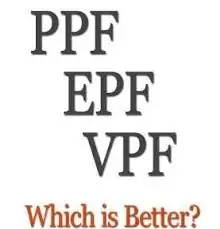Retirement planning has become the most talked about topic among people as young as 25. With so many investment options (Mutual Funds, Equity, ULIPs, NPS, Post office schemes, PPF, EPF Pension Plans etc.) coming up, it is becoming more difficult for youngsters to zero in on the most suitable retirement option. Going by the low risk average return (and vice versa) rule, the young population considers it wise to prefer EPF, VPF and PPF over all other options for investment/retirement. Let us understand why:
EPF, VPF and PPF: The Basics
EPF (Employee Provident Fund) – It is a provident fund created with a purpose to provide financial security and stability in future. Under this plan employees a save fraction of their salaries every month so that they can use it later at the time of retirement. It is mandatory for salaried people working in organizations registered under the Employees’ Provident fund Organization (EPFO) to contribute either 12% of their Basic + Dearness Allowance . There is more, the employee alone doesn’t contribute 12% of their salary, the employer as well contributes the same amount. Participation in EPF is mandatory for Employers who have more than 20 workers and for workers whose basic salary is more than Rs. 6,291. Also, the saved amount earns interest and is also eligible for tax deduction. The most attractive feature about EPF is that it is risk free and could be chosen as an investment tool to be used after retirement.
VPF (Voluntary Provident Fund) – As the name suggests, the employee availing VPF scheme can voluntarily contribute any percentage of his salary to the Provident fund account. Although, the contribution must be more than the PF ceiling of 12% that has been mandated by the government. The employer however is not obligated to contribute any amount towards VPF. An employee can contribute 100% of his basic salary and DA. Interest offered would be the same as EPF and this amount would be credited to EPF Scheme account only as there is no separate account for VPF.
PPF (Personal Provident Fund)
Personal Provident Fund – It is a A government-guaranteed fixed income security scheme with the special objective of providing old age financial security to the unorganized sector/ self employed (non-salaried employees). Everyone can contribute to PPF account and get risk free and assured returns. The interest earned on the PPF subscription is compounded; that means you not only earn interest in the money you put in, but you earn interest on the interest earned too. All the balance that accumulates over time is exempt from wealth tax.
Which one is better?
Now, that we have understood what PPF, EPF and VPF are, we need to find out, which is the one that stands out among all. A one on one comparison (between the 3 products) using factors like Eligibility, contribution, tax benefits, returns, withdrawal facility etc. would help us understand the pros and cons of each of them. This comparison would come handy while taking a decision regarding these products. Let us see how:
| EPF (Employee’s Provident Fund) | VPF (Voluntary Provident Fund) | PPF (Personal Provident Fund) | |
|---|---|---|---|
| Opening Account | Employees in India (Salaried Individuals) | Anyone except NRI’s | |
| Interest Rate | 8.75% p.a. | 8.75% p.a. | 8.7% p.a. |
| Tax Benefit | Up to Rs. 1 Lakh per year under Sec 80C | ||
| Period of Investment | Up to retirement or resignation, whichever is earlier | 15 years | |
| Loan Availability | Partial withdrawals available | 50% withdrawal after 6 years | |
| Employer Contribution on Basic + DA | 12% | NA | NA |
| Employee Contribution on Basic + DA | 12% | Voluntary | NA |
| Taxation on Maturity Returns | Tax Free | Tax Free | Tax Free |
Eligibility criteria:
People from unorganized sector including non-salaried employees are eligible to open a PPF account either at bank or in Post Office and earn the same assured high returns. While VPF and EPF scheme can only be availed by salaried individuals. VPF subscribers can contribute any amount over the necessary 12% which will be contributed in EPF account.
Contribution:
Besides EPF, both in VPF and PPF the contribution is voluntary. Only salaried individuals can sign up for VPF whereas PPF is for both salaried and non salaried individuals. An employee who wants to increase his retirement savings can tell the employer to deduct a certain percentage above the necessary 12% of basic pay and dearness allowance that goes towards EPF account. An employee can contribute around 100% of basic pay and dearness allowance towards VPF account (part of EPF). For VPF, the employer is not bound to contribute any amount.
Talking about the magnitude of contribution in each of the schemes, PPF account has an upper limit of Rs.1 lakh per year, whereas there is no such limit in case of VPF contribution. Also, one can contribute either a lump sum amount in the PPF account or distribute the investment amount into periodic payments.
Returns:
Presently, PPF account is offering an interest rate of 8.7%. However, since the interest rate on PPF is linked to 10-year government bond yields, it may change depending on the market but as government bonds are generally among the least risky financial products, the returns generally remain favorable. On the other hand, interest rate on VPF is not linked to G-bond yield and is the same as offered on EPF account. For the financial year, 2014-2015, EPF has fixed the rate at 8.75% which is only slightly greater than PPF rate.
Tax Benefits:
Maturity proceeds from EPF/VPF are tax exempted only if the employee has serviced the company for a continuous period of 5+ years. If he/she quits before completing 5 years, then the maturity returns would attract some tax. PPF returns on the other hand are tax free.
Investment Period:
VPF: Amount is payable at the time of retirement or resignation. Or, it can also be transferred from one employer to another if one switches jobs. On death, the accumulated balance is paid to the legal heir.
PPF: Amount can be withdrawn only on maturity, that is, after 15 years of the end of the financial year in which the product gets associated with a person.
Withdrawal facility:
In case of the PPF account that is to be maintained for a minimum of 15 years, only partial withdrawal is allowed subject to some terms and conditions The account can further be extended for another 5 years. However, the money from a VPF account can be fully and conveniently withdrawn. Further, if withdrawal from the VPF account happens prior to completing 5 years of service with the employer, then that amount would be taxed.
Loan facility:
For EPF/VPF, one can apply for a loan and also withdraw their complete investment, whereas, in PPF loans only 50% of the available balance at the end of 4th year can be withdrawn after the onset of the 6th year. In other words, full amount cannot be withdrawn.
Conclusion:
The investment options EPF, VPF and PPF have their own merits and demerits. From the above comparison we can observe that EPF and VPF score over PPF in terms of Return on investment, Employer Contribution, Liquidity. But we also know that EPF and VPF cannot be subscribed to by self-employed and employees in un-organized sector, therefore PPF is a better choice.
Also Read:













Useful information.
Very Nice Post Sir
Thank you
Such a good concept…..about the terminology of EPF, PPF.
Thanks to the team for delivering good knowledge.
nice explanation
very good idea I am satisfied with your message thanks
Thanks. But , as of now deduction as per 80c is allowed upto 150000 for PPF, EPF and vpf . Please correct.
1.5 Lacs Cap is only on PPF…Where as EPF+VPF has limit of 100% of your Basic Salary.For example if your Basic Salary is 25000/- PM(Plus other allowances) then you can contribute upto 3.0Lakhs PA.DA is not added in VPF.
Overall EPF+VPF is also A good tool to accumulate Post Retirement Corpus.
God limit to 25% of basic salary.
VPF limit is to 25%of basic salary
Contribution by employee to EPF is at maximum of 12% of salary+DA (as defined).
Contribution by employee to VPF is at maximum of 100% of salary+DA (as defined).
Contribution by employee to PPF is at maximum of 150,000 per year and has no linkage with your salary, etc. It can be opened by any resident of India irrespective of the occupation she is having.
Can NRI open PPF ac in India pl reply
Dear Atul
NRIs cannot open PPF account.Even when a Resident Indian changes his status to NRI then he cannot further contribute to his existing PPF Account.He can just hold it till maturity and can’t even renew it thereafter
The article has been written with good intent but has incorrect information. It seems to have been picked from some old article.
The upper limit is Rs 150,000/- per year and not Rs 1,00,000/-
The rate of interest for PPF is incorrect. The Ministry of Finance, Government of India announces the rate of interest for PPF account every quarter. The current interest rate effective from 1 January 2018 is 7.6% Per Annum’ (compounded annually). Interest will be paid on 31 March every year.
It is not personal provident fund but Public Provident Fund.
NRI cna continue to hold it till maturity and even contribute to it – the prohibition on this was introduced sometime back but was withdrawn.
Dear Sir ,
Useful information.However , I suppose, one may invest upto Rs 1,50,000/- per year in PPF Account .
Please clarify.
Rajesh you are right you can invest upto Rs 150,000/- in the PUBLIC PROVIDENT FUND (incorrectly written as Personal provident fund in the article). Even the interest rates are incorrect shown.
What in today’s time is the best interest rate offered and place to park your funds for Investment safely?
Simply discribe the difference between all three scheme really it’s very good for everyone knowladge.
ys meaning full
Useful information and beneficial to employees.
Excellent information
Thanks for providing this great information
Great
pl update the investment limit from 1 lakh to 1.5 lakh
Now a days people’s are searching for a good long term investment plan because they are earning more and more money. But all are confusing bcz which is better they didn’t knew. Anyway it’s a good information for all
1. PPF is Public Provident Fund & not Personal Provident Fund
2. Limit is Rs 150000/-
3. Contribution to PPF should be done within 5th of the month to earn interest for that month i.e. credit in Subscriber’s PPF a/c should be within 5th of the month or the system calculates interest from the next month irrespective of date of realization.
4. Maturity in PPF a/c will be 15 years from the end of the financial year in which account is opened irrespective of date of opening the account
Thankyou Sir
Goodarticle
Nice and Useful
Excellent knowledge and comparison .
Insurance also should be included with these schemes.
Excellent knowledge and comparison .
Insurance also should be included by government with these schemes.
Very usfull information
I think open all Employees
It is Contributory Provident Fund & not EPF as shown in Table.Present PPF Interest rate is 7.6%.
Important information regarding saving through PPF for common people those who are employed any where. This may enhanced to all for future savings.
This article contains useful information but a few points need to be corrected:
1. PPF is Public Provident Fund and not Personal Provident Fund
2. Tax benefit from PF + VPF and PPF is 1,50,000 INR and not 1,00,000 INR
3. Interest rate of these funds is 7.75% and not 8.75%. Seems to be old data
4. PPF account can be extended every 5 years after the initial 15 years. I am holding a PPF account for 25 years.
Thanks for information regarding extension of PPF account beyond 15 years.
I don’t remember when I signed up for this
How much amount can be invest in a financial year
J s Yadav
Interest for PPF 7.7% per annum please check the facts before posting
PPF is better than vpf i think, coz as per article, ppf gets compound interest whereas vpf doesn’t. 8.7 compound would do better than 8.75.. am I wrong in understanding?
PPF is better comparatively others
But many people they were loosing their seniority
Because they don’t know ppf transfer system previous company to present company
And also they don’t know benefits of after 10years regular maintaining of pf acct
KNOWN THING , NOTHING SPECIAL IN THIS ARTICLE.
D. BALU
TIRUPUR
TAMILNADU
“Soma Ghosh May 12, 2018 at 11:49 pm
This article contains useful information but a few points need to be corrected:
1. PPF is Public Provident Fund and not Personal Provident Fund
2. Tax benefit from PF + VPF and PPF is 1,50,000 INR and not 1,00,000 INR
3. Interest rate of these funds is 7.75% and not 8.75%. Seems to be old data
4. PPF account can be extended every 5 years after the initial 15 years. I am holding a PPF account for 25 years.”
This is correct information I am holding account for 23 years
please up-date the interest rate PPF as 7.6% and for EPF/VPF also reduced now.
Valuable information .Thank u
PLs give a information on vpf and mutual fund which is better.
Du u have any investment for NRI apart from this
Please make below clear !!’
PPF is better than vpf i think, coz as per article, ppf gets compound interest whereas vpf doesn’t. 8.7 compound would do better than 8.75.. am I wrong in understanding?
Thanks for providing this great information
Very good and useful articles.
Very Nice & useful information.
Very Informative post
Hello Sir, Information furnished in the article is very useful to all salaried employees.
But the EPFO is not safe gaurding the Welfare of employees. Most of employees epf amount recovered are not claiming by temporary Employees and crores of amount is in EPF corpus and the amount is not utislising.
Rules must be framed by Government to utilise the EPF funds for the Welfare of employees.
The Pensioners of EPS1995 should get maximum benefits.
A Good attempt ! It would have been better if this Article shows apportionment of employer & employee contribution to different funds under EPF & MP Act. Why not come out with a write up on Mutual Fund investment touching upon Dividend Distribution Tax (wef 1/4/2018). Thanks.
Nice sir
Very good information furnished. PPF is very good for the retired people.
It is to clarify one point: I would point out that the Employer is bound to contribute the Statutorily fixed amount along with the Employees ,but he is not bound to contribute any further amount even if the Employee prefers to contribute,in his own interest,under the EPF Scheme.Above all Under EPF Act ,Pension Scheme is introduced in 1996 and a part of the contributions made by both the Employee and the Employer go to this Scheme ,thus protecting the Employees in their old age
Every Indian poor or rich needs to invest in PPF. Minimum Rs 500 and maximum Rs 1.5 lac is the limit per year.Investment is not attached to any court decree.
Good Information but its not updated information. Limit is Rs.1.5lakh not Rs.1lakh. There is no comparison/ or risk reward or other information provided. Neverthless a good try.
EPF VPF PPF LIC
Insurance No No No YES
LOAN – – wait 50% for 6years YES
Interest % 7.5% it may vary 7.5% it may vary 7.5% it may vary 8.5% se upar
For more details about LIC, please- 97111-11775
iNVESTMENT IN PPF IS IMPORTANT.
Very useful information…Thank You!
THIS REALLY GOOD FUND
these schemes are much better than any mutual funds as there 3% more return interest than mutual funds.
IN mutual funds there is not more than 6 to 7% interest return. in three years .Money gets blocked for three years and we do not get the investment benefit of three years investment.
sp shaha
Sir,
Very helpful information. I have some more queries.
I have left the job and my PF amount is lying with the EPF. Also I am thinking of contributing to the account every year, is that allowed? How the interest is calculated in this case & when I can withdraw the amount?
A good attempt to post a comparative analysis of different Provident Fund schemes. But there is no mention of GPF , a compulsion for Govt employees. But it is painstaking to note that the financial figures regarding Interest, tax exemption, Limit of investment, etc are not quite correct and outdated. Proper care should have been taken for collection of current data and information before posting such an important issue.
Comment:I am 57 years old. I had eps deduction and could withdraw only my share from ppf. can I get pension from ppf department.
Very useful information…Thank You!
Information provided are back dated. Before posting article should be updated like interest rate, annual contribution, withdrawal rules etc.
thank u sir
Thank you very much for your useful information in this subject.
From 1.01.2018, interest rates are as follows for PPF:-
7.6% per annum (compounded yearly)
In post it is mentioned as 8.7 %, which is very old
How i can open VPF Account , Can you explain
so that we can open account
IN PPF the lock in period is 15 years.
Does it mean that the entire amount can be withdrawn after opening of accounts or the only amount which has completed 15 years.
How i can open VPF Account , Can you explain
so that we can open account
Very useful information
Current PPF interest is only 7.6%. When was this article written
Current interest rate in PPF is only 7.6%. When was this article written?
Sir ,
I am Central PSU employee.
My factory is seek and under BIFR from 1997.
Now most of employees increased VPF for investment as no regular salary by emlpoyer.
But company management is giving notice by Bord Of Directors resulation that –
employees should reduce VPF amount because company can not pay interest on VPF .
My question is this-
Can company give such directives or pressure to employees for VPF ..?
–
Dilip
Comments are closed.